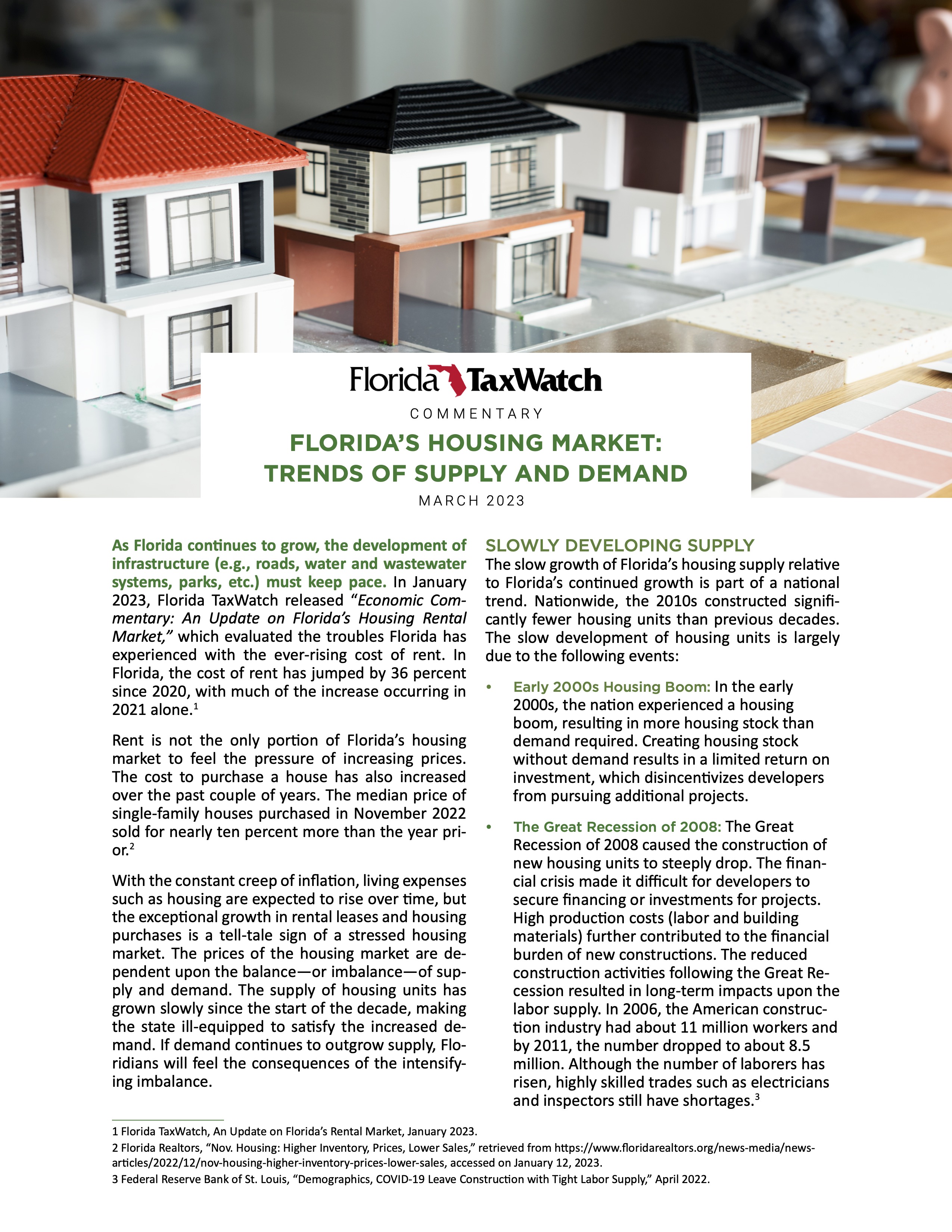Florida’s Housing Market: Trends of Supply and Demand
 As Florida continues to grow, the development of infrastructure (e.g., roads, water and wastewater systems, parks, etc.) must keep pace. In January 2023, Florida TaxWatch released “Economic Commentary: An Update on Florida’s Housing Rental Market,” which evaluated the troubles Florida has experienced with the ever-rising cost of rent. In Florida, the cost of rent has jumped by 36 percent since 2020, with much of the increase occurring in 2021 alone.
As Florida continues to grow, the development of infrastructure (e.g., roads, water and wastewater systems, parks, etc.) must keep pace. In January 2023, Florida TaxWatch released “Economic Commentary: An Update on Florida’s Housing Rental Market,” which evaluated the troubles Florida has experienced with the ever-rising cost of rent. In Florida, the cost of rent has jumped by 36 percent since 2020, with much of the increase occurring in 2021 alone.
Rent is not the only portion of Florida’s housing market to feel the pressure of increasing prices. The cost to purchase a house has also increased over the past couple of years. The median price of single-family houses purchased in November 2022 sold for nearly ten percent more than the year prior.
With the constant creep of inflation, living expenses such as housing are expected to rise over time, but the exceptional growth in rental leases and housing purchases is a tell-tale sign of a stressed housing market. The prices of the housing market are dependent upon the balance—or imbalance—of supply and demand. The supply of housing units has grown slowly since the start of the decade, making the state ill-equipped to satisfy the increased demand. If demand continues to outgrow supply, Floridians will feel the consequences of the intensifying imbalance.
The slow growth of Florida’s housing supply relative to Florida’s continued growth is part of a national trend. Nationwide, the 2010s constructed significantly fewer housing units than previous decades. Within the past couple of years, construction of housing units has begun to make a comeback in Florida. In 2021, a total of 213,500 housing units were authorized for construction, a 30.1 percent increase from the prior year.6 This number is high, second only to Texas,7 but the number is still less than the peak construction witnessed in 2005.
Although recent growth is promising, a legacy of high construction costs and supply chain disruptions continues to impede builder confidence. Using a monthly survey, the National Association of Home Builders/Wells Fargo Housing Market Index gauges whether builders think new single-family homes will have buyers within the next six months. In 2022, builder confidence dropped every month, and by December 2022, builder confidence reached its lowest level since 2012.8 In February 2023, home builder sentiment rose to 42 points, but anything under 50 points indicates a negative outlook.
As Florida’s population grows, demand for housing units will continue to grow. The growing demand, however, is not equally spread among all available housing units. The preferences associated with current demographic trends is causing a small portion of Florida’s housing supply to carry the brunt of demand. Historically, emerging generations entered the housing market with the purchase of “starter homes.” Starter homes are short-term, small housing units that are purchased by first-time homebuyers for their affordability and potential return on investment. Whether due to limited inventory or changing preferences, these houses are no longer the common purchase among first-time homebuyers.
The competitive housing market causes some would-be homebuyers to remain renters. Like house purchases, however, rental leases face scarcity after a decade of slow housing development. The extra pressure upon the rental market leads to higher prices.
While some households are able to keep pace with the ever-rising costs of housing, others cannot. Fast-growing prices make it increasingly difficult for lower-earning households to secure housing. Usually, rent is viewed as the most affordable housing option, but many households living in rentals are currently cost-burdened.
Limited housing options also hurt Florida’s ability to attract and retain young professionals. Even when individuals have high earning potentials, they typically start their careers with entry-level wages. While the median income of Florida’s experienced employees ($65,312) exceeds the state’s average median household income ($61,777), the same is not true for the median income of entry-level employees ($25,210). Some young professionals may choose to live with parents or roommates until they can afford their own home; however, others may be more inclined to find a job in a different community, or even a different state, to attain the living arrangements they prefer.
As Florida leaders attempt to resolve the tensions of the housing market, they should focus upon methods of expanding the housing supply. More specifically, Florida needs to develop multi-family units with rent that would be attainable to working Floridians and single-family units that would be attainable to first-time homebuyers and retirees.